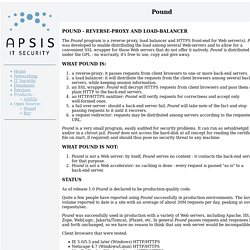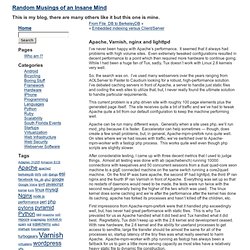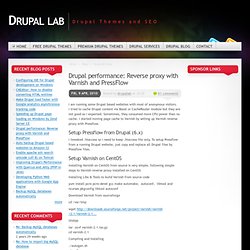

LoadBalancing – Varnish. Varnish has a built in load balancer.

Use this if you have more then one origin server. Using this is quite easy. SSL support. Thanks for your info.

But do you mean Varnish 2.0 won't support compression by itself, but rely on the backend to compress HTML pages? If so, then can it cache compressed pages? I need to offload the compression work from backend to the proxy, so probably cannot take advantage of this Vary feature. Dyskusja - Freebsd + Load Balancing dla apache i mysql. Creating high performance dynamic web sites with the Varnish HTT. Behind Varnish using Pound for SSL — Plone CMS: Open Source Cont. FAQ – Varnish. Gmbh. The Pound program is a reverse proxy, load balancer and HTTPS front-end for Web server(s).

Pound was developed to enable distributing the load among several Web-servers and to allow for a convenient SSL wrapper for those Web servers that do not offer it natively. Pound is distributed under the GPL - no warranty, it's free to use, copy and give away. Pound is a very small program, easily audited for security problems. It can run as setuid/setgid and/or in a chroot jail. Pound does not access the hard-disk at all (except for reading the certificate file on start, if required) and should thus pose no security threat to any machine. Stunnel.org. Varnish : Simple and Fast HTTP Acceleration. Apache, Varnish, nginx and lighttpd. I’ve never been happy with Apache’s performance.

It seemed that it always had problems with high volume sites. Even extremely tweaked configurations resulted in decent performance to a point which then required more hardware to continue going. While I had been a huge fan of Tux, sadly, Tux doesn’t work with Linux 2.6 kernels very well. So, the search was on. I’ve used many webservers over the years ranging from AOLServer to Paster to Caudium looking for a robust, high-performance solution. This current problem is a php driven site with roughly 100 page elements plus the generated page itself.
Using nginx, Varnish and Apache « syslog. Using nginx, Varnish and Apache The problem So lets get to the problem first.

I have several lightly to medium loaded sites running on some virtual servers, they servers themselves are highly configured to run beautifully on our host environments, very, very RAM intensive but low disk I/O and low CPU usage. As mentioned, the sites are relatively low loaded, they'll generally hang around at between 3,000-5,000 unique hits a day and are run through Apache using PHP, various PHP modules and MySQL, a simple generic LAMP environment, yet customised to suit it's surroundings and host. Varnish and Apache2. One client had some issues with Apache2 and a WordPress site.

While WordPress isn’t really a great performer, this client had multiple domains on the same IP and dropping Nginx in didn’t seem like it would make sense to solve the immediate problem. First things first, we evaluated where the issue was with WordPress and installed db-cache and wp-cache-2. We had tried wp-super-cache but had seen some issues with it in some configurations. Immediately the pageload time dropped from 41 seconds to 11 seconds. Since the machine was running on a quadcore with 4gb ram and was running mostly idle, the only thing left was the 91 page elements being served. Introduction – Varnish. For many years the old standby for caching was Squid, a caching proxy server that with the right magic could be turned into a fairly functional http accelerator.

While Squid performed quite well for those willing to do the work to configure it properly, at its heart it's still a forward proxy and it could be somewhat difficult to get it to do exactly what you wanted it to. Enter Varnish. Reverse proxy with Varnish and PressFlow. Drupal performance. Dr. I am running some Drupal based websites with most of anonymous visitors.

I tried to cache Drupal content via Boost or CacheRouter module but they are not good as i expected. Sometimes, they consumed more CPU power than no cache. Manual:Varnish caching. Varnish is a lightweight, efficient reverse proxy server[1] which reduces the time taken to serve often-requested pages.

Like Squid, Varnish is an HTTP accelerator which stores copies of the pages served by the web server. The next time the same page is requested, Varnish will serve the copy instead of requesting the page from the Apache server. This caching process removes the need for MediaWiki to regenerate that same page again, resulting in a tremendous performance boost.[2] Varnish has the advantage of being designed specifically for use as an HTTP accelerator (reverse proxy). It stores much of its cached data in memory, creating fewer disk files and fewer accesses to the filesystem than the larger, more multi-purpose Squid package. Letsgetdugg. Update 2010-02-19: Seems other people are also affected by the Varnish LINGER crash on OpenSolaris.

This does not address the core problem but removes the “fail fast” behavior with no negative side effects. r4576 has been running reliably with the fix below. In varnishd/bin/cache_acceptor.c if (need_linger) setsockopt(sp->fd, SOL_SOCKET, SO_LINGER, &linger, sizeof linger); How to install varnish. Experimenting with Varnish. Varnish (software) The project was initiated by the online branch of the Norwegian tabloid newspaper Verdens Gang. The architect and lead developer is Danish independent consultant Poul-Henning Kamp (a well-known FreeBSD core developer), with management, infrastructure and additional development originally provided by the Norwegian Linux consulting company Linpro.
The support, management and development of Varnish was later spun off into a separate company, Varnish Software. VarnishFeatures – Varnish. Mozilla Firefox. Installing Varnish Web cache on a CentOS 5 VM — Lucid Solutions. May 2010: Varnish v2.0.6 is part of EPEL (Original article is from March 2008) Varnish is not part of the CentOS distribution, EPEL, ATRpms, etc. Binary x86_64 RHEL5 RPM's are on the sourceforge site. Download the two binary RPM's and install them. As per the FAQ, varnish requires a complier to compile the configuration. Installation In theory we could download the binary RPM's and use yum to install them [4]; however the sourceforge binary RPM's aren't signed (and/or I haven't installed the GPG key), so just manually install the prerequisite packages, and then use rpm to install the two varnish rpms.
Performance – Varnish. MOC Systems: High perfomance TYPO3 with varnish proxy. Mailing List Archive: Re: varnish with ssl.